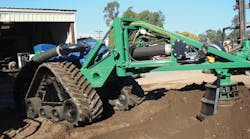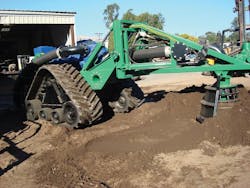Tornado Motion Technologies, El Cajon, Calif., separates itself from the rest of the dredging industry by focusing its resources on creating specialty dredges that truly are environmentally friendly.
TMT’s research and development team has created dredging technology unavailable anywhere else in the world. “Our dredging technology is so far advanced that we can dredge at higher production rates with higher percent solids than any conventional dredge without the need for a cutter head,” says TMT’s Ben Weinrib, mechanical engineer. TMT recently developed a completely submersible amphibious dredge (Sub-Dredge) that is independent of its main platform to provide versatility the dredge industry has not seen before. This equipment relies on TMT’s powerful Eddy Pump, which is particularly well suited to sensitive remediation projects. TMT’s equipment safely and efficiently removes more contaminants than conventional methods, so there is less opportunity to compromise drinking water quality during sediment removal.
Makeup of the machine
TMT’s Sub-Dredge is a rubber track based platform approximately 16 8½ 7½ ft. A main dredge pump i s mounted between the tracks with its suction line routed to the front of a swing boom and angled down into a rotating head. The boom on the front swings 6 ft to the left and right while the pump removes sediment at up to 350 yd3/hr.
The operator can watch the operation via two submersible cameras mounted on each side of the boom. (The Eddy Pump produces minimal turbidity; otherwise, the cameras would be virtually useless.) Other sensors monitor the orientation of the machine and automatically make changes as required. The machine can also be equipped with positional software that locates the dredge on a virtual map for tracking and recording progress in real time on a monitor.
The operator sits in a joystick chair on a floating or land-based platform and watches a PLC touch screen, the cameras, and the positional computer monitor. The swing is activated by selecting automatic or manual mode on the touch screen and shifting the joystick left or right. To advance the machine to the next position, the operator pushes forward on the joystick controlling the track drives. This joystick also controls drive direction.
Hydraulics is used to control four main systems on the machine;
• boom swing,
• boom lift,
• digging head rotation, and
• pipeline valves.
The swing system uses two 4-in. bore, 32-in. stroke cylinders with 2-in. stainless steel rods. The lifting system employs two 4-in. bore, 24-in. stroke cylinders, also with 2-in. diameter stainless steel rods. The digging head system is powered by a low-speed, high-torque radial-piston motor driven by a closed-circuit, variable-displacement pump. If so equipped, two pipe line valves are controlled by a 2½-in. bore, 8-in. stroke cylinder with 1-in. rod.
The entire hydraulic system is served by a 75-hp hydraulic power unit. This machine often works in environmentally sensitive areas; therefore Chevron Clarity hydraulic oils are used in the system because they pass the acute aquatic toxicity (LC-50) criteria adopted by the U.S. Fish and Wildlife Service and the U.S. Environmental Protection Agency.
Advantages of hydraulics
Hydraulics was chosen because actuators are compact, lightweight, and powerful. The components are rugged and less complicated then their electromechanical counterparts and inherently water-proof.
The Sub-Dredge is controlled by a PLC that uses pressure transducers to monitor loads and make positional adjustments as required by the operation. Electrohydraulic flow control valves are integrated with the PLC for controlling speeds of different actuators. The machine can operate in areas inaccessible to traditional suction equipment, yet still provide aggressive digging and high production dredging. The use of hydraulics has kept the size of the machine as compact as possible without sacrificing strength and performance.
Submitted by Ben Weinrib, mechanical engineer, Tornado Motion Technologies, El Cajon, Calif. Call (619) 258-7020 or visit www.tornadomotion.com.


